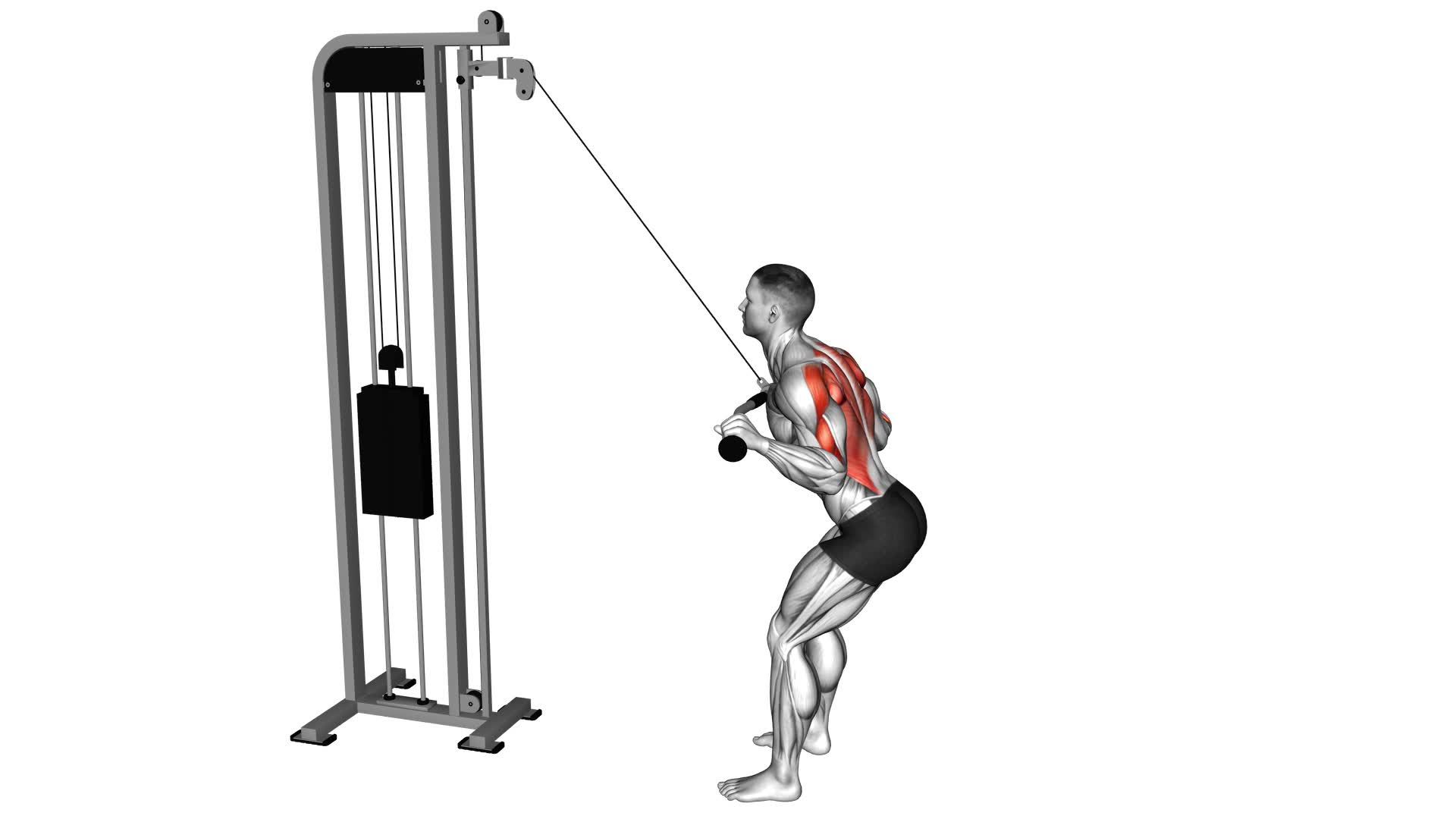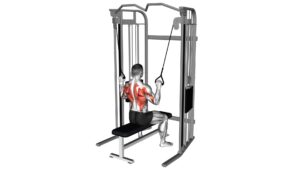Cable Standing Lat Pulldown – Video Exercise Guide & Tips

Are you looking to strengthen your back and build upper body strength?
Watch This Exercise Video
The cable standing lat pulldown is a great exercise for you!
In this video exercise guide, we will show you the proper form and technique to perform this exercise effectively.
We will also provide variations and modifications to challenge yourself.
By avoiding common mistakes and following our tips, you can maximize your results and achieve a stronger, more toned back.
Let's get started!
Key Takeaways
- Cable standing lat pulldown increases back strength and targets multiple muscle groups.
- Proper form and technique, such as keeping the back straight and engaging core muscles, should be maintained during the exercise.
- Breathing techniques, including inhaling during the eccentric phase and exhaling during the concentric phase, should be followed to maintain a steady and controlled breathing pattern.
- Incorporating cable standing lat pulldown into a full body workout, such as pairing it with other upper body exercises and adjusting the weight for challenge, can enhance overall fitness level.
Benefits of the Cable Standing Lat Pulldown
To maximize your back and arm strength, you can benefit from performing the Cable Standing Lat Pulldown. This exercise is highly effective in improving posture and increasing back strength. By targeting the latissimus dorsi muscles, also known as the lats, the Cable Standing Lat Pulldown helps to strengthen the upper back and shoulders. Stronger lats contribute to better posture by pulling the shoulders back, reducing the risk of slouching and rounded shoulders. Additionally, this exercise engages the muscles in your arms, including the biceps and forearms, enhancing overall upper body strength.
The Cable Standing Lat Pulldown is an excellent choice for individuals looking to improve their posture and increase back strength. By incorporating this exercise into your routine, you can develop a strong and stable upper body. However, to reap the full benefits and prevent injury, it's crucial to ensure proper form and technique.
In the next section, we'll discuss the correct way to perform the Cable Standing Lat Pulldown, including important tips and considerations. So, let's dive into the details of proper form and technique for this exercise.
Proper Form and Technique for the Exercise
Start by securely attaching the cable handle to the pulldown machine at a height that allows you to fully extend your arms overhead. To ensure proper form and technique for the cable standing lat pulldown, keep the following points in mind:
- Stand facing the pulldown machine with your feet shoulder-width apart.
- Imagine yourself rooted to the ground, maintaining a stable and balanced stance.
- Grasp the handle with an overhand grip, slightly wider than shoulder-width apart.
- Imagine your hands as hooks, focusing on engaging your back muscles rather than relying on your arms.
- Keep your core engaged and your chest lifted throughout the movement.
- Imagine a string pulling your chest towards the ceiling, maintaining a tall posture.
- Initiate the movement by pulling your shoulder blades down and back.
- Imagine squeezing a pencil between your shoulder blades as you pull the handle towards your upper chest.
Incorporating the cable standing lat pulldown into your workout routine effectively involves dispelling common misconceptions and understanding its benefits. Contrary to popular belief, this exercise isn't just for the back but also targets the biceps and shoulders. To make the most of this exercise, aim for controlled and deliberate movements, focusing on engaging the targeted muscles. By incorporating the cable standing lat pulldown into your routine, you can improve your upper body strength and posture.
Transitioning into the subsequent section about variations and modifications to try, let's explore how you can add variety to your cable standing lat pulldown routine.
Variations and Modifications to Try
Now, let's explore some ways you can add variety to your cable standing lat pulldown routine.
One option is to try alternative grip options. Instead of using the standard overhand grip, you can experiment with an underhand grip or a mixed grip, where one hand is supinated and the other is pronated. These alternative grips can target different muscles in your back and arms, providing a fresh challenge to your workout.
Another modification you can try is incorporating resistance bands into your cable standing lat pulldown. By attaching resistance bands to the cable machine and then gripping the bands instead of the bar, you can increase the resistance and intensity of the exercise. This can be particularly beneficial for individuals who've reached a plateau in their lat pulldown strength or want to add an extra challenge to their routine.
Remember to always maintain proper form and technique, regardless of the variation or modification you choose. Start with lighter weights or resistance bands to ensure that you can perform the exercise correctly and avoid injury. As you become more comfortable and confident, gradually increase the weight or resistance to continue challenging your muscles.
Common Mistakes to Avoid
Be mindful of these common mistakes to ensure proper form and maximize the effectiveness of your cable standing lat pulldown. Proper technique is crucial for targeting the right muscles and avoiding injuries. Here are some common mistakes to avoid:
- Using too much weight: It's tempting to load up the cable machine with heavy weights, but using excessive weight can compromise your form and lead to injury. Start with a weight that allows you to perform the exercise with proper technique.
- Relying on momentum: Swinging your body or using momentum to pull the cable down takes away from the effectiveness of the exercise. Instead, focus on using your lat muscles to initiate the movement and control the weight throughout the entire range of motion.
- Neglecting the scapular retraction: One of the key components of the cable standing lat pulldown is to retract your scapulae (shoulder blades) as you pull the cable down. This engages your lat muscles and ensures proper activation.
- Failing to maintain a neutral spine: Keep your back straight and avoid arching or rounding your spine during the exercise. This helps to protect your lower back and maintain proper form.
Tips for Maximizing Your Results
To maximize your results with the cable standing lat pulldown, focus on implementing these tips for proper form and technique.
First, it's important to incorporate the cable standing lat pulldown into a full body workout. This exercise primarily targets the muscles in your back, but it also engages your shoulders, biceps, and core. By including it in your routine, you can ensure that you're working your entire body and achieving a balanced workout.
Another crucial tip is to pay attention to your breathing during the exercise. Proper breathing helps to stabilize your core and maximize the effectiveness of the lat pulldown. As you pull the bar down, exhale and engage your core muscles. This will help you maintain stability and control throughout the movement. Inhale as you release the bar and allow your muscles to relax before starting the next repetition.
By incorporating the cable standing lat pulldown into a full body workout and focusing on proper breathing, you can maximize your results. Remember to always maintain proper form, keeping your back straight and your shoulders relaxed.
With consistency and dedication, you'll see improvements in your back strength and overall fitness level.
Frequently Asked Questions
How Much Weight Should I Use for the Cable Standing Lat Pulldown?
When it comes to weight selection for the cable standing lat pulldown, it's important to consider your fitness level and goals.
Start with a weight that challenges you but allows you to maintain proper form throughout the exercise.
Gradually increase the weight as you get stronger and more comfortable with the movement.
Remember, using too much weight can compromise your form and increase the risk of injury.
Focus on maintaining proper technique rather than lifting the heaviest weight possible.
Can I Perform the Cable Standing Lat Pulldown if I Have a Shoulder Injury?
If you have a shoulder injury, it's important to be cautious when performing the cable standing lat pulldown. This exercise can put strain on your shoulders, potentially worsening your injury.
It's recommended to consult with a healthcare professional or a qualified trainer who can assess your specific situation and suggest modifications or alternative lat exercises that are safer for your shoulder.
Your safety and well-being should always come first.
Is It Necessary to Warm up Before Doing the Cable Standing Lat Pulldown?
Before performing the cable standing lat pulldown, it's important to warm up. Warming up has several benefits, such as increasing blood flow to the muscles and preparing them for the exercise. It also helps prevent injuries and improves overall performance.
If you're unable to do the cable standing lat pulldown, there are alternative exercises you can try, such as the seated lat pulldown or the bent-over row.
Can I Do the Cable Standing Lat Pulldown on a Smith Machine Instead of a Cable Machine?
Yes, you can do the cable standing lat pulldown on a Smith machine instead of a cable machine. However, it's important to note that the Smith machine provides a fixed bar path, which may limit your range of motion compared to using a cable machine.
The cable standing lat pulldown offers more freedom of movement, engaging your core and stabilizer muscles.
How Often Should I Include the Cable Standing Lat Pulldown in My Workout Routine?
To maximize the benefits of the cable standing lat pulldown, it's important to include it in your workout routine regularly. How often to do the exercise depends on your individual goals and fitness level.
However, a general recommendation is to perform the cable standing lat pulldown 2-3 times per week. This exercise targets your latissimus dorsi muscles and helps improve upper body strength and posture.
Remember to start with a weight that challenges you but allows for proper form to avoid injury.
Conclusion
In conclusion, the cable standing lat pulldown is an effective exercise for targeting the latissimus dorsi muscles and improving upper body strength.
By maintaining proper form and technique, and avoiding common mistakes, you can maximize your results from this exercise.
Additionally, trying variations and modifications can help to add variety and challenge to your workouts.
Incorporate the cable standing lat pulldown into your routine for impressive gains in your back muscles.

Author
Years ago, the spark of my life’s passion ignited in my mind the moment I stepped into the local gym for the first time. The inaugural bead of perspiration, the initial endeavor, the very first surge of endorphins, and a sense of pride that washed over me post-workout marked the beginning of my deep-seated interest in strength sports, fitness, and sports nutrition. This very curiosity blossomed rapidly into a profound fascination, propelling me to earn a Master’s degree in Physical Education from the Academy of Physical Education in Krakow, followed by a Sports Manager diploma from the Jagiellonian University. My journey of growth led me to gain more specialized qualifications, such as being a certified personal trainer with a focus on sports dietetics, a lifeguard, and an instructor for wellness and corrective gymnastics. Theoretical knowledge paired seamlessly with practical experience, reinforcing my belief that the transformation of individuals under my guidance was also a reflection of my personal growth. This belief holds true even today. Each day, I strive to push the boundaries and explore new realms. These realms gently elevate me to greater heights. The unique combination of passion for my field and the continuous quest for growth fuels my drive to break new ground.



